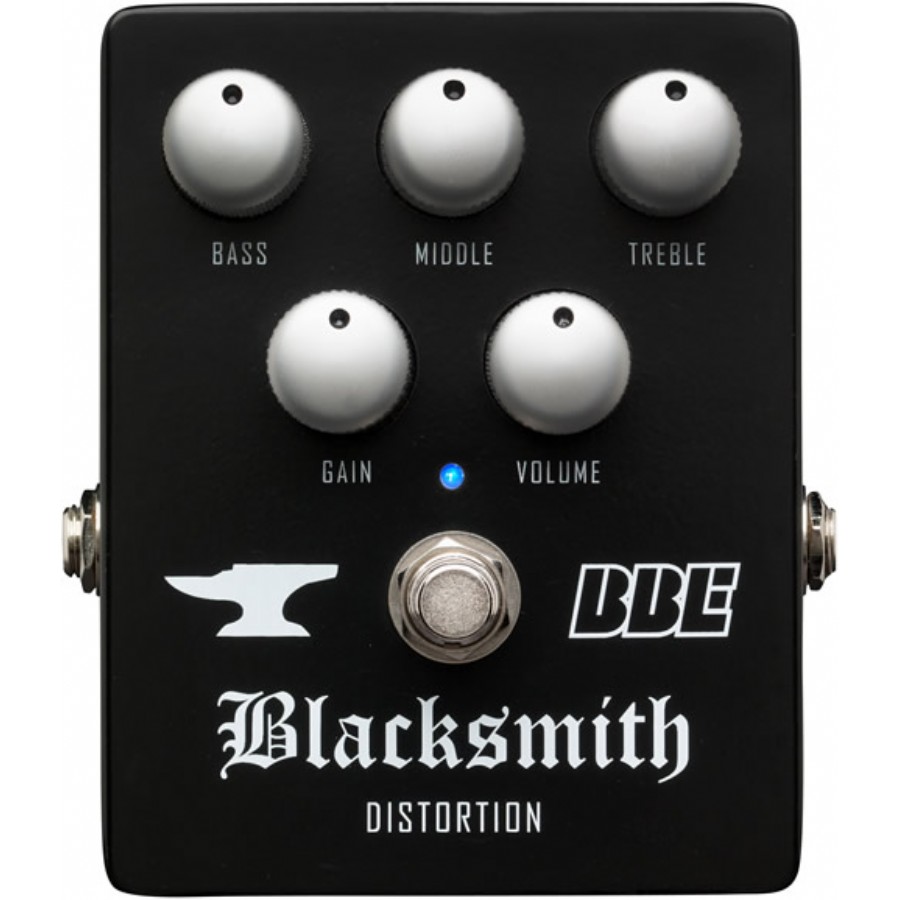BBE Blacksmith Distortion BD-69P - Distortion Pedalı
The Blacksmith™ analog distortion is all about force feeding your tube amp for a heavier, chunkier distortion. The concept was developed by Paul Gagon in the 1980s when he worked at Jackson Guitars. Back then, Gagon created pickups, amps and electronics for Jackson instruments and routinely worked with an A-list of artists, from Jeff Beck to Steve Vai and many more. What he found was many of the artists loved the sound of their Marshalls but wanted more grind out of them. Their amps may have gone “to eleven,” but these guys often told Gagon they wanted them to “go to fifteen or twenty.”
Paul already had created many boost and distortion circuits, but ultimately, what he wanted to make a pedal for artists that would go beyond what a boost pedal could do while maintaining that classic Marshall tonal balance – but on steroids. The solution was brilliant: a distortion generation circuit feeding a 3-band passive EQ derived from a ’69 Plexi (a Plexi “Tone Stack”). The EQ allows you dial it in to suit the characteristics of a particular tube amp, a practical feature because some Marshalls were dark while others were bright sounding. Of course, the EQ is also great for style: want a killer shred tone? Scoop those mids and crank the lows and highs.
Blacksmith is inspired by those pedals Gagon hand-made back in the ‘80s, delivering all the tone he brought to the rock gods but with greater consistency and durability. Blacksmith features 1% metal-film resistors, big fat signal traces on a mil-spec circuit board, true hardwire bypass to eliminate any pickup loading when disengaged, and a 1meg Ohm input resistance to welcome your axe’s signal with wide open arms – just like the input on a killer Marshall.
The Blacksmith isn’t just for Marshalls, however. Gagon’s design works beautifully with a variety of other quality tube amps, from Mesa to Fender. When you’re looking for a top shelf distortion pedal that’s as musical as your amp, get your hands on a Blacksmith.
Tech Focus: LED distortion circuit
When many people think of LEDs, they think of flashlights. So what is an LED doing in a distortion circuit? Well, it’s not there to illuminate the inside of the pedal. Before we get into LEDs, let’s take a look at the basics of a distortion circuit. Since the late ‘60s many distortion circuits have used a diode to create the distortion. As the signal passes through the diode, it will turn a sine-wave into a square-wave, “clipping” the top and bottom of the sine-wave, resulting in a massive amount of even and odd order harmonics generated. That’s the distortion sound.
An LED is a Light Emitting Diode, but in a distortion circuit it won’t actually emit light because the current passing through it is far too low. In this case, the LED is used to accomplish the same function as a silicon “small signal diode” which is a basic rectifying device. The primary benefit of an LED is that it has a greater voltage swing, about +/- 1.4 volts versus a silicon diode which has a voltage swing of about a +/ 0.7 volts. That means an LED is capable of a higher output level, driving the input of an amp harder and making the tubes clip (distort) more. There’s more to it, though. An LED can provide a smoother transition in-to and out-of the clipped ends of the wave-form, creating less of the very high harmonics that might be described as “shrill.” While post-EQ can manage those harmonics, the LED-based distortion circuit in the Blacksmith offers smoother distortion to start with.
So how where did this idea of using an LED for distortion come from? Turns out that Paul Gagon came up with the LED idea around the same time as his friends at Tom Sholz’ Rockman. In a conversation with one of the Rockman engineers, Paul explained how he figured out that the properties of an LED would be practical for a distortion circuit, and in fact some of the Jackson artists had raved about pedals he’d made for them. Keep in mind that many artists were using both Jackson guitars and Rockmans for practice. The Rockman guys told Paul they’d found the very same solution with LEDs, and had started making their own LED-based distortion circuits. We think it’s this is a great example of how great engineers often come to the same conclusions, and in this case, between Gagon’s pedals and the Rockman products, so much of the most memorable, searing metal tones of the ‘80s were created.
Features :
- Gain, volume and passive 3-band PLEX-EQ controls
- LED-based gain circuit for smooth, high-output distortion
- 1MEG Ohms input impedance for proper pickup loading
- 1K Ohms output impedance when engaged
- 1% metal-film resistors for consistency
- High-voltage poly caps for better tone
- Military-spec circuit board for reliability
- Blue status LED for high visibility and low power consumption
- Easy access battery compartment
- True hardwire bypass
BBE Blacksmith Distortion BD-69P Distortion Pedalı Müşteri Yorumları
toplam 0 yorum
Henüz yorum yok
Bu ürün için henüz yorum yapılmamış. İlk yorumu yaparak diğer kullanıcılar ile paylaşabilirsin.


